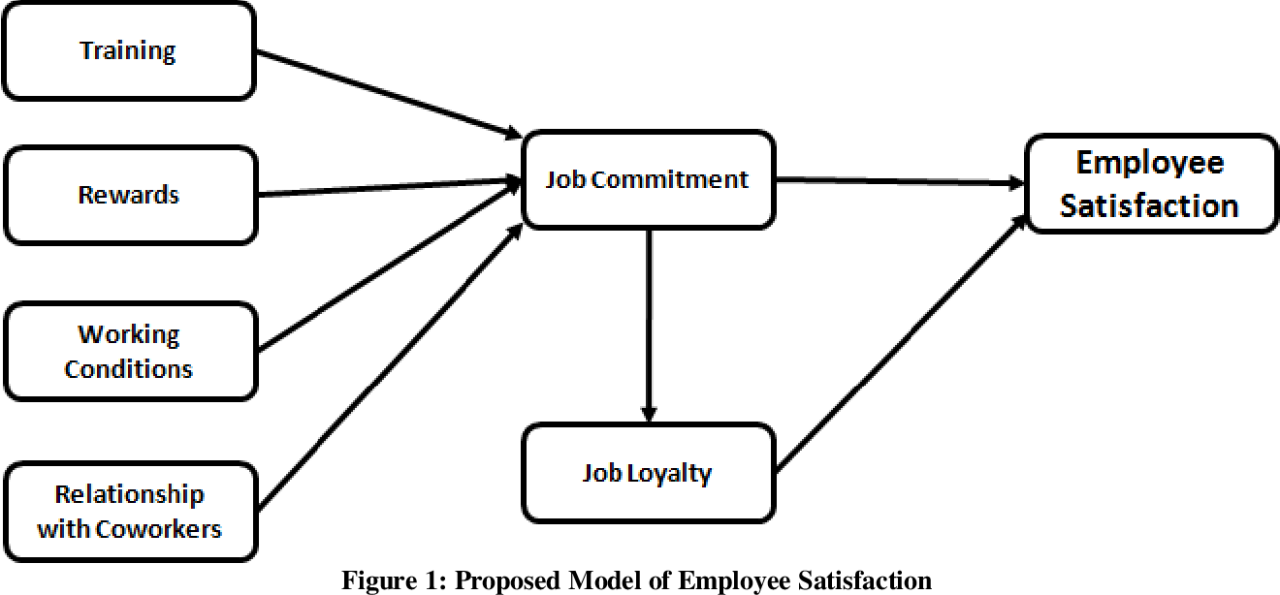Insight Blog
Agility’s perspectives on transforming the employee's experience throughout remote transformation using connected enterprise tools.
24 minutes reading time
(4759 words)
Range of Affect Theory – A Brief Primer On Job Satisfaction Models
Discover job satisfaction models and theories, including the Range of Affect Theory, and improve employee well-being and organizational performance.
In today's fast-paced, ever-evolving work landscape, understanding the intricacies of job satisfaction is crucial for both employers and employees. There are various job satisfaction models and job satisfaction theories that can help us to do this.
This article delves into the fascinating world of job satisfaction models, with a special focus on the Range of Affect Theory.
We will also explain Edwin A Locke's Range of Affect Theory and Affect Theory of Job Satisfaction. Let's start!
Key Takeaways
- Range of Affect Theory offers a unique approach to understanding job satisfaction and individual differences in affective experiences.
- Affect Theory of Job Satisfaction says positive affect drives satisfaction and negative affect causes dissatisfaction.
- Other Job Satisfaction Models provide complementary perspectives and can be used with the Range of Affect Theory.
- Applying job satisfaction models in the workplace leads to identifying job satisfaction drivers and designing effective interventions.
- Dimensions of Job Satisfaction: Pay, promotion, supervision, co-workers, and nature of work are important factors to consider.
- Ongoing research and practice are necessary for developing and applying job satisfaction models to improve employee well-being and organizational performance.
Range of Affect Theory – A Complete Guide
What is Range of Affect Theory?
The Range of Affect Theory is a psychological framework that explores the role of emotions in determining an individual's job satisfaction.
Developed by Edwin A. Locke, this theory posits that job satisfaction results from the balance between positive and negative affective experiences in the workplace.
- According to the theory, higher job satisfaction comes from more positive, fewer negative emotions
- Affective experiences include emotions, feelings, and moods during work
- Influences can be job tasks, colleague relationships, organizational culture, management practices
Understanding Edwin A Locke's Range of Affect Theory
Delving into the heart of the Range of Affect Theory, it is essential to grasp the key concepts and principles that underpin this influential framework. They provide valuable insights into the intricate relationship between emotions and job satisfaction in the workplace.
1. Affective Experiences
The Range of Affect Theory emphasizes the importance of both positive and negative emotions in shaping an individual's job satisfaction.
Positive affective experiences, such as feelings of accomplishment, satisfaction, and pride, contribute to higher job satisfaction levels.
In contrast, negative affective experiences, like frustration, disappointment, and anger, can lead to lower job satisfaction.
2. Emotional Balance
According to the theory, job satisfaction is determined by the balance between positive and negative affective experiences.
Employees who have a higher proportion of positive emotions compared to negative emotions will generally be more satisfied with their jobs.
Conversely, those who experience more negative emotions than positive ones will have lower job satisfaction.
According to Edwin A Locke's Range of Affect Theory:
- Emotional balance is crucial to job satisfaction
- Positive emotions lead to increased satisfaction
- Negative emotions result in decreased satisfaction
- Striking a balance between emotions is key
- Individual differences impact emotional balance
- Organizational factors influence emotional experiences
- Strategies to promote positive emotions to enhance satisfaction
3. Affective Disposition
The Range of Affect Theory recognizes that an individual's affective disposition or overall emotional tendency can influence their perception of job satisfaction.
Employees with a more positive affective disposition are likely to interpret work-related events more positively, resulting in higher job satisfaction.
4. Job-Related Factors
The theory also considers the influence of various job-related factors on affective experiences.
Factors such as job autonomy, task variety, feedback, and goal setting can affect the balance of positive and negative emotions, thereby impacting job satisfaction.
5. Organizational Culture and Management Practices
The Range of Affect Theory underscores the role of organizational culture and management practices in shaping employees' emotional experiences. Supportive and inclusive work environments that encourage open communication, collaboration, and employee recognition can foster positive affective experiences. Ultimately, it leads to higher job satisfaction.
Key Takeaway
By understanding and applying the key concepts and principles of the Range of Affect Theory, organizations can develop strategies to enhance job satisfaction. It can also help boost employee experience and improve workplace performance.
How does the Range of Affect Theory Work?
Relationship Between Job Satisfaction and Affective Experiences
The Range of Affect Theory posits that job satisfaction is closely linked to affective experiences.
This is associated with employees' emotions, feelings, and moods throughout their workday.
These experiences can arise from multiple facets of the work environment. For example, job tasks, interpersonal relationships, organizational culture, and management practices.
The theory suggests that the balance of positive and negative affective experiences determines the overall level of job satisfaction.
Influence of Positive and Negative Emotions on Job Satisfaction
According to the Range of Affect Theory, both positive and negative emotions play a crucial role in shaping job satisfaction:
Positive Emotions
Feelings of accomplishment, satisfaction, and pride contribute to higher job satisfaction. Employees who experience positive emotions related to their work are more likely to feel engaged, motivated, and fulfilled in their roles.
Positive emotions can arise from various sources, such as successfully completing tasks, recognition from peers or supervisors, and supportive work environments.
Negative Emotions
On the other hand, negative emotions, like frustration, disappointment, and anger, can undermine job satisfaction.
These emotions can stem from challenging work situations, conflicts with colleagues, or inadequate management practices.
Experiencing a high level of negative emotions in the workplace can lead to disengagement, reduced motivation, and, ultimately, lower job satisfaction.
Tips for Applying Edwin A Locke's Range of Affect Theory in the Workplace
There are three main strategies to consider when applying the Range of Affect Theory:
- Enhancing positive affective experiences
- Minimizing negative affective experiences, and
- Encouraging open communication and feedback
We will explore these strategies one by one.
1. Enhancing Positive Affective Experiences
Enhancing positive affective experiences in the workplace is essential for creating a supportive environment that fosters motivation, engagement, and satisfaction. Here's a step-by-step process to help you enhance positive affective experiences among your employees:
Step 1: Assess the Current Work Environment
Conduct surveys, interviews, or focus groups to gather employee feedback on the existing work atmosphere and areas that need improvement
Identify the factors that contribute to positive and negative emotions at work.
Step 2: Develop a Plan
Include short-term and long-term goals, as well as specific actions to promote positive affective experiences
Step 3: Implement the Plan
Communicate the plan to your team and ensure everyone understands the goals and their role in achieving them.
Begin implementing the strategies, such as recognition programs, team-building activities, or workplace improvements.
Step 4: Monitor Progress
Regularly evaluate the impact of your initiatives on employee well-being and job satisfaction.
Collect feedback from employees to gauge their experiences and identify any areas that need further improvement.
Step 5: Adjust and Refine the Plan
Based on the feedback and evaluation results, adjust your plan as necessary to maximize positive affective experiences.
Continue refining and improving your strategies to create a positive work environment that benefits both employees and the organization.
Step 6: Foster a Culture of Positivity
Encourage open communication, constructive feedback, and mutual support among team members
Make enhancing positive affective experiences an ongoing priority by embedding these values into the organization's culture
By following this step-by-step process, you can create a workplace that nurtures positive emotions and enhances overall employee well-being, leading to higher levels of motivation, engagement, and productivity.
2. Minimizing Negative Affective Experiences
Minimizing negative affective experiences in the workplace is essential to create a supportive and healthy work environment. Negative emotions can lead to disengagement, low productivity, and increased turnover.
Here's a step-by-step process to help you minimize negative affective experiences among your employees:
Step 1: Identify Sources of Negative Emotions
Conduct surveys, interviews, or focus groups to gather employee feedback on the sources of stress, frustration, and other negative emotions at work.
Analyze the data to pinpoint specific issues that contribute to a negative work environment.
Step 2: Develop a Plan to Address the Issues
Based on your findings, create a strategic plan that targets the identified sources of negative emotions.
Include short-term and long-term goals, as well as specific actions to minimize negative affective experiences.
Step 3: Communicate the Plan to Your Team
Share the plan with your employees, ensuring they understand the goals and their role in achieving them.
Encourage their active involvement in the process and listen to their suggestions for improvement.
Step 4: Implement the Plan
Begin executing the strategies outlined in the plan, such as conflict resolution training, workload management, or implementing a policy against workplace harassment
Ensure all employees are aware of the available resources and support systems.
Step 5: Monitor Progress and Gather Feedback
Regularly evaluate the impact of your initiatives on employee well-being and job satisfaction.
Collect feedback from employees to gauge their experiences and identify any areas that need further improvement.
Step 6: Adjust and Refine the Plan
Based on the feedback and evaluation results, adjust your plan as necessary to better minimize negative affective experiences.
Continue refining and improving your strategies to create a more positive work environment.
Step 7: Foster a Culture of Resilience and Support
Encourage open communication, constructive feedback, and mutual support among team members.
Promote resilience-building practices, such as mindfulness and stress management techniques, to help employees better cope with challenges.
By following this step-by-step process, you can create a workplace that minimizes negative emotions and fosters a healthier, more supportive environment for employees, leading to increased motivation, engagement, and productivity.
3. Encouraging Open Communication and Feedback
Encouraging open communication and feedback is crucial for fostering a supportive and collaborative work environment. It promotes transparency, trust, and continuous improvement, increasing employee satisfaction and better overall performance. Here's a step-by-step process to help you encourage open communication and feedback among your employees:
Step 1: Establish a Culture of Open Communication
Communicate to your team the importance of open communication and feedback for the success of the organization.
Lead by example, demonstrating transparency, active listening, and a willingness to provide and receive feedback.
Step 2: Implement Clear Communication Channels
Set up appropriate communication channels for different types of feedback, such as team meetings, one-on-one sessions, and anonymous suggestion boxes. Ensure that employees understand the purpose and function of each channel and feel comfortable using them.
Step 3: Train Employees on Effective Communication and Feedback
Provide training sessions on communication skills, active listening, and giving and receiving constructive feedback.
Encourage employees to practice these skills in their daily interactions with colleagues and supervisors.
Step 4: Set Up Regular Feedback Opportunities
Schedule regular team meetings, one-on-one sessions, and performance reviews for employees to share their feedback and discuss their concerns.
Encourage peer-to-peer feedback and provide opportunities for employees to collaborate and learn from one another.
Step 5: Foster a Safe and Non-Judgmental Environment
Create an atmosphere where employees feel comfortable sharing their thoughts, ideas, and concerns without fear of retaliation or judgment.
Encourage managers and supervisors to be approachable and receptive to employee feedback.
Step 6: Act on the Feedback Received
Take employee feedback seriously and demonstrate that their opinions are valued by taking appropriate action in response.
Communicate the changes and improvements made as a result of employee feedback, highlighting the impact on the organization.
Step 7: Monitor Progress and Adjust the Process
Regularly evaluate the effectiveness of your communication and feedback initiatives.
Gather feedback from employees on the process and make adjustments as needed to improve continuously.
Step 8: Recognize and Reward Open Communication
Acknowledge and appreciate employees who actively participate in open communication and provide constructive feedback.
Consider incorporating communication and feedback skills into employee evaluations and rewards systems.
By following this step-by-step process, you can create a workplace that encourages open communication and feedback, leading to a more supportive and collaborative environment where employees feel heard, valued, and empowered to contribute to the organization's success.
Affect Theory of Job Satisfaction – What Is It & How Does It Work?
What is the Affect Theory of Job Satisfaction?
The Affect Theory of Job Satisfaction is a theory that explains job satisfaction as an emotional response to a job. According to this theory, employees' emotions and moods play a significant role in their job satisfaction. The theory proposes that three components of affect - emotions, moods, and dispositional - influence job satisfaction.
The Three Components of Affect: Emotions, Moods, and Dispositional Affect
The Affect Theory of Job Satisfaction proposes that there are three components of affect that can influence an employee's job satisfaction: emotions, moods, and dispositional affect.
These components are different from each other and can impact job satisfaction differently.
1. Emotions in Affect Theory of Job Satisfaction
Emotions are brief, intense feelings that are triggered by specific events or situations at work. For example, an employee may feel happy after receiving a promotion or angry after being criticized by their manager. Emotions are generally short-lived, lasting only a few minutes to a few hours.
The Affect Theory of Job Satisfaction suggests that emotions can significantly impact job satisfaction. Positive emotions can lead to higher job satisfaction, while negative emotions can lead to lower job satisfaction. Therefore, creating positive emotional experiences at work can be an effective way to improve job satisfaction.
2. Moods in Affect Theory of Job Satisfaction
Moods are longer-lasting feelings that are not necessarily triggered by a specific event or situation but can influence job satisfaction over time. For example, an employee may feel generally happy or anxious for several days or weeks. Various factors, including work environment, workload, and personal life can influence moods.
The Affect Theory of Job Satisfaction suggests that moods can also significantly impact job satisfaction. Negative moods, such as anxiety or depression, can lower job satisfaction. Positive moods, such as contentment or joy, can increase job satisfaction. Therefore, creating a positive work environment and reducing sources of stress can be effective ways to improve job satisfaction.
3. Dispositional Affect in Affect Theory of Job Satisfaction
Dispositional affect refers to an individual's inherent tendency to experience positive or negative emotions. Some individuals are naturally more optimistic and tend to experience positive emotions more frequently, while others are naturally more pessimistic and tend to experience negative emotions more frequently.
The Affect Theory of Job Satisfaction suggests that dispositional affect can also significantly impact job satisfaction. Individuals with a more positive dispositional affect tend to have higher job satisfaction, while individuals with a more negative dispositional affect tend to have lower job satisfaction. Therefore, it is important to consider individual differences in dispositional affect when managing and supporting employees.
How to Apply the Affect Theory of Job Satisfaction in the Workplace
Here is how you can apply Affect Theory of Job Satisfaction in the workplace:
- Promote positive emotions by providing opportunities for employees to experience positive emotions such as recognition, rewards, and social events.
- Reduce negative emotional experiences by addressing sources of stress and conflict, providing support and resources, and promoting work-life balance.
- Foster emotional intelligence by providing training and resources for employees to better understand and manage their own emotions and the emotions of others.
- Consider individual differences in dispositional affect when managing and supporting employees.
Why is the Affect Theory of Job Satisfaction Important?
The Affect Theory of Job Satisfaction is important for several reasons. Understanding the role of affect in job satisfaction can provide insights into why employees feel the way they do about their work and what can be done to improve their job satisfaction. Here are some of the reasons why the Affect Theory of Job Satisfaction is important:
1. Provides a More Comprehensive View of Job Satisfaction
The Affect Theory of Job Satisfaction recognizes that emotions, moods, and dispositional affect are all important components that influence job satisfaction. By considering all of these factors, the theory provides a complete understanding of job satisfaction.
2. Offers Practical Implications for Improving Job Satisfaction
The theory suggests that creating positive emotional experiences and reducing negative emotional experiences can improve job satisfaction. This provides practical guidance for managers and organizations to promote job satisfaction in the workplace.
3. Helps to Identify and Address Sources of Dissatisfaction
By understanding how affect influences job satisfaction, managers can identify and address sources of dissatisfaction in the workplace. For example, if employees are experiencing negative emotions due to a high workload, managers can take steps to reduce workload and promote work-life balance.
4. Highlights the Importance of Emotional Intelligence
The Affect Theory of Job Satisfaction emphasizes the importance of emotional intelligence in the workplace. This includes the ability to understand and manage one's own emotions as well as the emotions of others. Organizations can improve communication, teamwork, and job satisfaction by promoting emotional intelligence.
5. Recognizes Individual Differences in Job Satisfaction
The theory acknowledges that individuals have different dispositional effects, which can influence their job satisfaction. Managers can better support employees and promote job satisfaction by recognising and accommodating these individual differences.
Tips for Applying the Affect Theory of Job Satisfaction
Here are some tips for applying the Affect Theory of Job Satisfaction in the workplace:
1. Promote Positive Emotional Experiences
Create opportunities for employees to experience positive emotions, such as recognition, rewards, and social events. Encourage positive interactions among employees and celebrate their achievements. This can help to create a positive emotional climate in the workplace, leading to higher job satisfaction.
2. Reduce Negative Emotional Experiences
Address sources of stress and conflict in the workplace, such as heavy workloads, lack of support, and interpersonal conflict. Provide resources and support for employees to manage stress and improve work-life balance.
By reducing negative emotional experiences, employees are less likely to experience job dissatisfaction.
3. Foster Emotional Intelligence
Provide training and resources for employees to better understand and manage their own emotions and the emotions of others. This can help to improve communication, teamwork, and conflict resolution, leading to higher job satisfaction.
4. Consider Individual Differences in Dispositional Affect
Recognize that employees have different dispositional affects, which can influence their job satisfaction. Accommodate these individual differences by providing support and resources tailored to their specific needs.
5. Use Feedback to Promote Positive Affect
Provide regular feedback to employees, focusing on their strengths and achievements. This can help to promote positive affect and increase job satisfaction.
6. Encourage a Sense of Purpose
Help employees to understand the importance of their work and how it contributes to the overall mission of the organization. This can help to create a sense of purpose and meaning in their work, leading to higher job satisfaction.
7. Encourage Work Autonomy
Give employees a sense of control over their work by allowing them to make decisions and take ownership of their tasks. This can lead to a sense of accomplishment and higher job satisfaction.
By applying these tips, managers, and organizations can create a positive work environment that promotes job satisfaction and well-being.
Other Job Satisfaction Models
1. Herzberg's Two-Factor Theory
Herzberg's Two-Factor Theory is a well-known job satisfaction model that proposes that there are two distinct sets of factors that influence job satisfaction and motivation.
The first set of factors is hygiene factors, which are essential for preventing dissatisfaction but do not necessarily lead to satisfaction when present. These factors include things such as salary, job security, working conditions, and company policies.
The second set of factors is motivators, which are the factors that directly lead to job satisfaction and motivation. These factors include things such as challenging work, recognition, responsibility, and personal growth opportunities.
Key points from Herzberg's Two-Factor Theory
Here are the key points from Herzberg's Two-Factor Theory:
- Herzberg's Two-Factor Theory proposes that two distinct sets of factors influence job satisfaction and motivation.
- Hygiene factors are essential for preventing dissatisfaction but do not necessarily lead to satisfaction when present.
- Motivators are the factors that directly lead to job satisfaction and motivation.
- To prevent job dissatisfaction, managers need to focus on providing adequate hygiene factors.
- To truly motivate employees and improve job satisfaction, managers must focus on providing motivators such as meaningful work, opportunities for growth and development, and recognition for good performance.
- This requires a deep understanding of individual employee needs and preferences and a commitment to ongoing communication and feedback.
2. Job Characteristics Model
The Job Characteristics Model is a job satisfaction model that proposes that there are five core job characteristics that can lead to higher levels of job satisfaction and motivation.
These characteristics include skill variety, task identity, task significance, autonomy, and feedback.
According to the model, jobs that have high levels of these characteristics tend to be more meaningful, enjoyable, and motivating for employees.
Key Points of Job Characteristics Model
Keypoints of the Job Characteristics Model are given below:
- The Job Characteristics Model proposes that there are five core job characteristics that can lead to higher levels of job satisfaction and motivation.
- These characteristics include skill variety, task identity, task significance, autonomy, and feedback.
- Jobs that have high levels of these characteristics tend to be more meaningful, enjoyable, and motivating for employees.
- To improve job satisfaction and motivation, managers must focus on designing jobs with high levels of these characteristics.
- This requires a deep understanding of individual employee needs and preferences and a commitment to ongoing communication and feedback.
- The model highlights the importance of job design as a key factor in promoting job satisfaction and well-being.
3. Social Information Processing Model
The Social Information Processing Model is a job satisfaction model that proposes that social and organizational context can significantly influence job satisfaction.
According to this model, employees use social cues and information to form their perceptions of the work environment and their job satisfaction.
This includes the social norms, values, and expectations that are present in the workplace.
Key Points of the Social Information Processing Model
According to the Social Information Processing Model:
- The Social Information Processing Model proposes that social and organizational context can significantly influence job satisfaction.
- Employees use social cues and information to form their perceptions of the work environment and job satisfaction.
- Social comparison is a key factor in job satisfaction, and employees compare themselves to their peers and colleagues regarding job satisfaction, pay, and status.
- Open and transparent communication can help to create a positive work environment and improve job satisfaction.
- Managers must create a positive social and organizational context to improve job satisfaction.
- This includes promoting positive social interactions, setting clear expectations and values, and providing employee feedback and support.
- Managers need to be aware of the impact of social comparison on job satisfaction and take steps to ensure that employees feel valued and supported in their work.
4. Equity Theory
Equity Theory is a job satisfaction model that proposes that employees compare their inputs and outcomes to those of others in the workplace.
According to this theory, employees want to be treated fairly and equitably. In addition, they feel a sense of injustice if they perceive that they are not receiving fair treatment. This can lead to job dissatisfaction and turnover.
Equity Theory suggests that there are three primary types of inequity that can occur in the workplace.
The first is underpayment inequity, which occurs when employees feel they are being paid less than others for the same work.
The second is overpayment inequity, which occurs when employees feel they are being paid more than others for the same work.
The third is procedural inequity, which occurs when employees feel they are not being treated fairly in the decision-making processes that affect their work.
Key Points of the Equity Theory
Key points of the Equity Theory are given below:
- Equity Theory proposes that employees compare their inputs and outcomes to those of others in the workplace.
- Employees want to be treated fairly and equitably and feel a sense of injustice if they perceive that they are not receiving fair treatment.
- Three primary types of inequity exist: underpayment, overpayment, and procedural.
- To improve job satisfaction and reduce turnover, managers need to ensure that their employees are treated fairly and equitably.
- This includes addressing instances of inequity, such as adjusting pay structures or providing opportunities for employee input and feedback.
- Procedural fairness is also important for job satisfaction, and managers should ensure that employees feel they have a voice in decision-making processes.
Comparison of Job Satisfaction Theories and Models
As we explained earlier, the Affect Theory focuses on emotional experiences, and Herzberg's Two-Factor Theory focuses on hygiene factors and motivators.
Likewise, the Job Characteristics Model focuses on job design, and the Social Information Processing Model focuses on social and organizational context. Equity Theory focuses on fairness and comparison of inputs and outcomes.
Each theory has practical implications for managers and organizations to improve job satisfaction and reduce turnover.
Table: Comparison of Job Satisfaction Theories and Models
| Theory | Key Concepts | Practical Implications |
| Affect Theory of Job Satisfaction | Emotions, moods, and dispositional affect | Promote positive emotional experiences, reduce negative emotional experiences, foster emotional intelligence |
| Herzberg's Two-Factor Theory | Hygiene factors and motivators | Focus on providing adequate hygiene factors, focus on providing motivators |
| Job Characteristics Model | Five core job characteristics | Design jobs that have high levels of skill variety, task identity, task significance, autonomy, and feedback |
| Social Information Processing Model | Social and organizational context, social comparison | Create a positive social and organizational context, be aware of the impact of social comparison |
| Equity Theory | Comparison of inputs and outcomes | Ensure employees feel that they are being treated fairly and equitably, address instances of inequity |
Wrapping Up
Understanding job satisfaction models is crucial for designing effective interventions to increase employee satisfaction and productivity. The Range of Affect Theory, developed by Edwin A Locke, provides a unique approach to identifying job satisfaction drivers and individual differences in affective experiences. Additionally, the Affect Theory of Job Satisfaction, the Job Characteristics Model, Herzberg's Two-Factor Theory, and the Social Exchange Theory offer complementary perspectives on job satisfaction.
The integration of these theories can lead to a more comprehensive understanding of job satisfaction in the workplace. Ongoing research and practice are necessary to further develop and apply these models to improve employee well-being and organizational performance.
Frequently Asked Questions About Range of Affect Theory
What Is Range of Affect Theory by Edwin Locke?
The Range of Affect Theory is a job satisfaction model developed by Edwin A Locke. It suggests that job satisfaction is determined by the range of affect individual experiences on the job, which is influenced by job characteristics and individual differences.
What Are the 4 Theories of Job Satisfaction?
The four main theories of job satisfaction are the Range of Affect Theory, the Job Characteristics Model, Herzberg's Two-Factor Theory, and the Social Exchange Theory. These theories provide different perspectives on what contributes to job satisfaction and can be used to design interventions to increase employee satisfaction.
What Are the 5 Dimensions of Job Satisfaction?
The five dimensions of job satisfaction are pay, promotion opportunities, supervision, co-workers, and the nature of the work itself. These dimensions were first identified by Smith, Kendall, and Hulin in their study of job satisfaction.
Who Introduced Affect Theory?
Affect Theory was first introduced by Weiss and Cropanzano in 1996. They proposed that affect, which refers to an individual's emotional experiences, plays a critical role in determining job satisfaction and organizational behavior.
What Are the Two Main Theories of Life Satisfaction?
The two main theories of life satisfaction are the Set-Point Theory and the Life Domains Theory. The Set-Point Theory suggests that individuals have a predetermined level of happiness that is difficult to change, while the Life Domains Theory proposes that satisfaction with different life domains, such as work, relationships, and leisure, contributes to overall life satisfaction.
What Are the Four 4 Causes of Job Satisfaction?
The four main causes of job satisfaction are the work itself, social interactions at work, pay, and benefits, and opportunities for advancement. These factors are often cited as important contributors to overall job satisfaction.
Categories
Blog
(2612)
Business Management
(323)
Employee Engagement
(212)
Digital Transformation
(174)
Growth
(119)
Intranets
(113)
Remote Work
(61)
Sales
(48)
Collaboration
(36)
Project management
(29)
Culture
(28)
Customer Experience
(26)
Knowledge Management
(21)
Leadership
(20)
Comparisons
(6)
News
(1)
Ready to learn more? 👍
One platform to optimize, manage and track all of your teams. Your new digital workplace is a click away. 🚀
Free for 14 days, no credit card required.

















